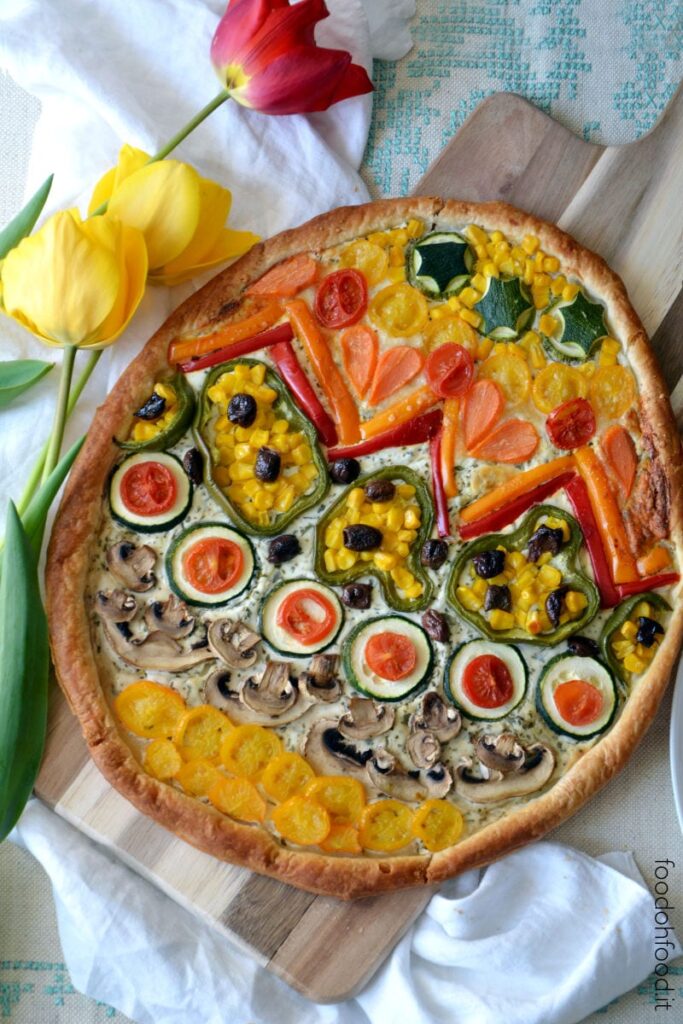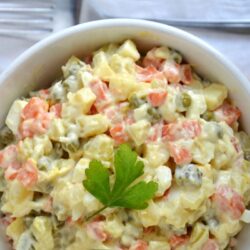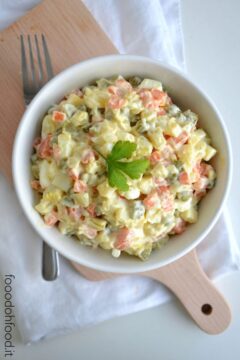Traditional Russian vegetable salad – tips and tricks
Scorrere verso il basso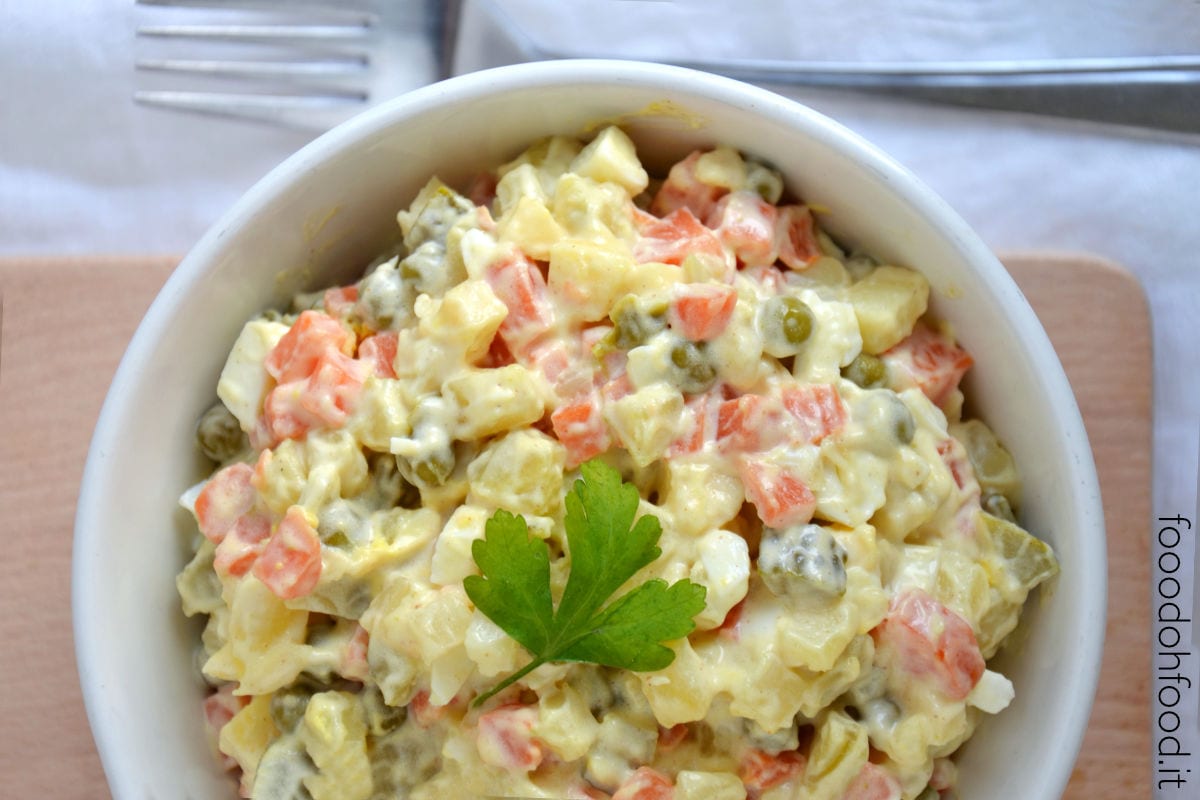
Today I would like to prepare with you the recipe for the Russian vegetable salad in its full splendor while following various cooking and preparation tips and tricks and analyzing the tradition, variations and reinterpretations. The recipe for Russian salad is one of the Easter traditions (and not only) in various countries of Northern and Eastern Europe. In my Polish family we have been preparing it for generations for both Christmas and Easter and I can honestly say that I have tasted at least 10 versions of it between the holidays of friends or relatives. The secret to a good Russian salad is the balance of flavors and textures so I always go back to our super tested family recipe which is enjoyed and copied by everyone who has ever tasted it.
The base of boiled and diced vegetables such as carrots and potatoes mixed with peas, gherkins and seasoned with creamy mayonnaise create a rich and tasty appetizer. You can use it as a side dish, appetizer or to fill puff pastry or voulevant baskets.
You will find the advice and explanations of the variants here below. If, on the other hand, you want to go directly to the Russian salad recipe that we have used in my family for generations, you will find it at the bottom of this post.
Tips and tricks
How to cook vegetables?
I recommend cooking the vegetables in their skins once they have been washed well under running water. They hold their shape and texture better while they are cooling down.
Cook your vegetables in salted water or vegetable broth. Vegetables cooked in vegetable broth have a sweet and intense flavor and you can reuse the cooking water to create a soup base. If you cook vegetables in water only, pour enough water to cover them and be sure to add salt.
What kind of peas to use?
It is a completely personal choice of your taste buds. You can choose to use frozen peas or the canned ones. As a child, I loved canned peas and stole them every time my mother made Russian salad. As you have guessed, I still love them and for this reason I prefer to use the canned ones. If you choose frozen peas, cook them briefly following the instructions on the box.
Hard-boiled eggs?
I recommend dicing only the whites and mashing the yolks with mayonnaise or crumbling them in the salad. Eggs must be cooked just right and not overcooked. If overcooked the yolk will turn gray in color and will have a characteristic sulfur smell which will affect both the flavor and the smell of the salad. Each of us uses different methods to cook eggs. You will find my explanation of how I always have perfect boiled eggs within the recipe.
The mayonnaise?
You can use either store bought mayonnaise or homemade mayonnaise. You can lighten the final sauce by replacing a small part (1 tablespoon) of the mayonnaise with Greek yogurt. In both cases, a good Russian salad must follow one rule: the mayonnaise is just the addition and not the main ingredient, don’t overdo it with the quantity. The vegetables use the sauce to stick together and acquire some of its flavor, they don’t have to swim in it. Adding too much sauce will make your salad too heavy.
I also highly recommend adding mustard to mayonnaise which will make the sauce interesting and it will enhance the flavor of the vegetables. If you use dijon mustard beware of its spicy aftertaste which may not be liked by everyone.
Variants
Adding the apple is my absolute favorite variation. It may seem strange but trust me when I tell you that the apple adds a magical touch to the whole salad. It combines a sweet note with the crunchiness which is so useful for salads full of very soft ingredients. I recommend using a small addition of apple (for 1 kg of salad I use half a medium apple) which has a firm consistency and it is not too sweet.
You can replace the peas with small white beans.
Adding cooked beetroot not only adds a very distinctive flavor note but also changes the color of the salad.
If you add a small amount of onion, I warn you that from the second day onwards the strong flavor of the onion begins to prevail over that of the vegetables.
I also happened to taste versions with pickled olives, corn or celery root.
The addition of tuna, cooked ham or boiled chicken is quite common but as you can imagine it is no longer the traditional Russian vegetable salad but goes towards its not so distant relative, namely Oliver salad.
And now let’s move on to my tried and tested family recipe. Enjoy your meal.
Traditional Russian vegetable salad – tips and tricks
Ingredients
- 2-3 medium carrots
- 3-4 medium potatoes
- 3 medium eggs
- 5-6 medium pickled cucumbers
- ½ not too sweet apple
- 130 g canned peas
- 160-200 ml mayonnaise
- 1-2 tbsp mustard
Instructions
Traditional Russian vegetable salad – tips and tricks
- Scrub the vegetables under cold running water but do not peel them. Put them in a saucepan, add water, salt or vegetable broth. Cook over medium heat for about 20 minutes. Remove the vegetables when they are tender but still firm and not overcooked. Remove the smaller ones faster (carrots, small potatoes), the bigger ones later.
- To prepare boiled eggs. Put the eggs at room temperature in a saucepan, cover them with water and put on the heat. When the water comes to a boil you have to lower the heat slightly and set the timer for 8 minutes. After this time put your eggs immediately in cold water for at least 5 minutes. This will stop the cooking process and make the eggs easier to peel.
- When the vegetables are cold, peel them and cut them into cubes. Peel and cut half of the apple and the pickled cucumbers into cubes. Add the peas and finally the chopped boiled egg. Separately chop the white from the yolk.
- Add the mayonnaise and mustard and mix. Let it rest in the refrigerator for several hours. Taste and adjust with more salt, pepper, mayonnaise or mustard if needed. At this point you can also add more chopped cucumbers or peas. I remind you that the Russian salad will become even better after several hours of rest in the refrigerator when all the flavors are blended.
Note from the author of this recipe
- I just want to tell you that I really appreciate that you have decided to prepare my recipe. If you like it, I would be very happy and it could be a huge help for me if you follow me on my official social channel such as instagram where I publish every time a new recipe comes out. To become my follower just search for foodohfood in your instagram or click on this link: https://www.instagram.com/foodohfood/ and press Follow. Thank you from the bottom of my heart, Barbara. ^_^
Notes
Nutrition
To be kept in the refrigerator and consumed within 3 – 4 days.
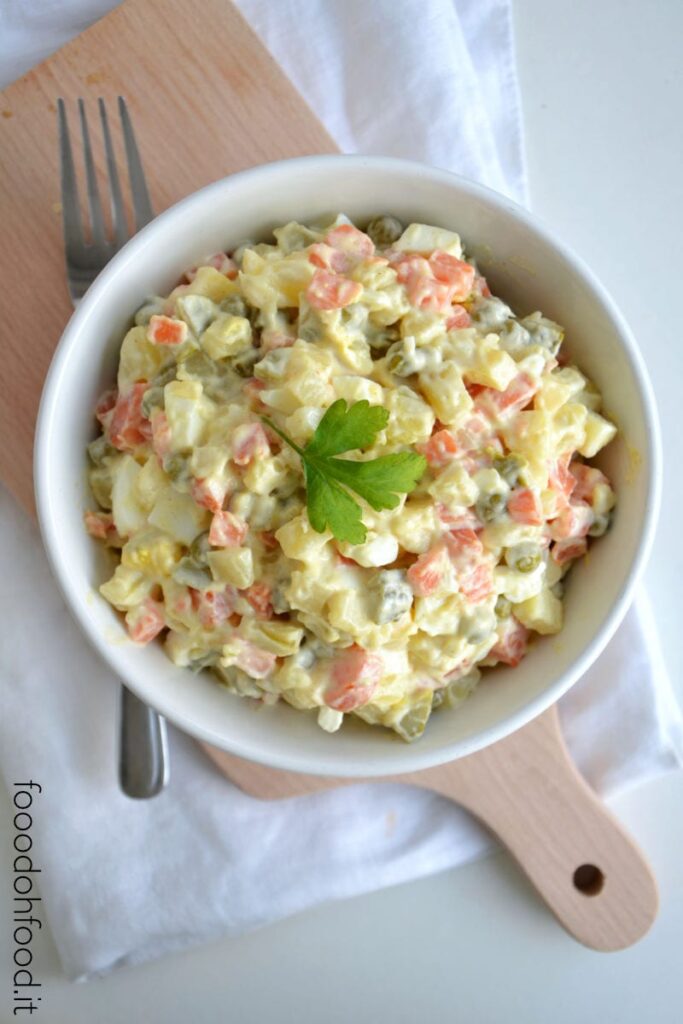
p.s. If you are looking for some other delicious recipes for Eastercheck my Quick and easy egg appetizer for Easter (photo below) or Puff pastry Easter egg tart – easy vegetarian appetizer idea (photo below).

